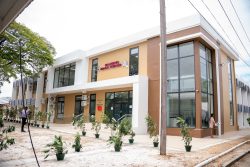I always try and use a standard seed tray box for sowing seeds. A standard seed tray has an inside measurement of 14˝ x 8˝ x 2˝. Nowadays seed trays are made from plastic. In the old days (just post-war) they were made out of wood. Many still are, and they are very easy to make. The pieces of wood used to provide the base are 14˝ long and a fraction less than 4˝ wide, so that a small space is left for drainage but not large enough for compost to run out. In the old days gardeners used to place a layer of rotted leaf mould over the base of the box to act as a kind of reservoir for water, but also to prevent compost running out. The practice of putting a layer of leaf mould over the base has gone out because of the damage that could and did occur to the roots when seedlings were lifted out for potting off. They would put down masses of roots into the leaf mould. Plastic trays with their very small holes do not let much compost run out, while they also last a good deal longer than wooden ones.
Seed trays should be filled to within a quarter of an inch of their top. Simply fill the box, strike off the compost level with the top, press it down with your fingers around the edges and in the corners, and level the surface. I have a board the same size as the box which I use to press the soil down to produce a firm but evenly compressed surface to within ¼˝ of the top of the box. Sowing seed should be done evenly and thinly using a fine sieve to cover seed lightly with compost. Very fine seeds are not covered at all. Watering can be done with a fine rose on a watering can, allowing the water to fall gently over the surface. It may be safer to stand the trays or pots in a few inches of water so that it moves upwards through the soil to the surface by a process known as capillarity. Germination is nearly always rapid. A standard seed tray will hold 300 evenly sown lettuce or tomato seeds or seed of zinnias, marigolds or peppers. Once seedlings start to appear they should be ‘pricked’ out into pots or boxes as soon as they are large enough to be handled. But what about the compost you might ask? Nowadays there is a shortage of good old fashioned soil (loam) and the emphasis is on soil-less composts, mostly comprising sand and peat. Here in Guyana there is a very good (imported) compost called Promix. However, being a bit old fashioned I always prefer to avoid soil-less composts and stick to that on which I was weaned (horticulturally that is), for there is no doubt that if you get the watering wrong with products like Promix you can do a lot of damage.
The composts I make up and use are based on the formula devised by the John Innes Horticultural Institute in Britain. John Innes seed compost is made up of 2 parts loam, 1 part peat, and 1 part sand. I can’t get peat so the alternative I use is either well-rotted leaf litter from the forest floor, or very well-rotted cow mould which has had all the nutrients leached (washed) out of it. All the ingredients must pass through an ⅛˝ sieve. The ratio is 2:1:1 by volume. The proportions of John Innes potting compost are 7:3:2 by volume of loam, peat (or substitute) and sand, and is a little coarser, since it is passed through a ⅜˝ sieve and then mixed thoroughly. Both JI seed compost and JI potting compost have a certain amount of fertilizer added to give the seedlings a start once they germinate.
Good luck and may your God go with you.








